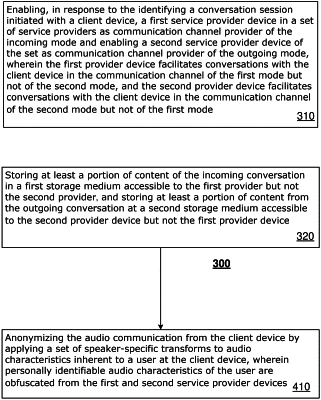| CPC G06F 21/6254 (2013.01) [G06N 3/04 (2013.01); G06N 3/08 (2013.01); G10L 13/00 (2013.01); G10L 15/16 (2013.01); G10L 15/18 (2013.01); G10L 15/22 (2013.01); G10L 15/30 (2013.01); G10L 2015/223 (2013.01)] | 20 Claims |

|
1. A computer-implemented method, executed in one or more processors of a server computing device, comprising:
enabling a first service provider device in a set of service providers as a communication channel provider of an incoming communication mode and enabling a second service provider device of the set as a communication channel provider of an outgoing communication mode, wherein the first service provider device is enabled to facilitate conversations with a client device in the incoming communication mode but is not enabled to facilitate conversations of the outgoing communication mode, and the second service provider device is enabled to facilitate conversations with the client device in the outgoing communication mode but is not enabled to facilitate conversations of the incoming communication mode, at least one of the incoming communication and outgoing communication modes comprising an audio communication;
storing at least a portion of content of a conversation in the incoming communication mode in a first storage medium accessible to the first service provider device but not the second service provider device, and storing at least a portion of content of the conversation in the outgoing communication mode at a second storage medium accessible to the second service provider device but not the first service provider device; and
anonymizing the audio communication by applying a speaker-specific transform function to audio characteristics associated with a user at the client device in conjunction with sending data content of the audio communication to the set of service provider devices, wherein personally identifiable audio characteristics inherent to the user are obfuscated from the first and second service provider devices.
|